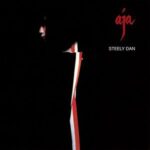 Some albums in your collection, however important they are musically, take on an importance in your life that goes way beyond some sounds coming out of boxes in the corner. Sometimes an album worms its way through your defences to connect up with all sorts of other parts of life and, before you know it, the songs have become inextricably entangled with memories of friends, family and lovers; and there’s no way of untying those knots. “Aja” is one of those albums for me; it has mellow memories of my student years, memories of friends met along the way and tragic memories of one of those friends taken when she had everything before her.
Some albums in your collection, however important they are musically, take on an importance in your life that goes way beyond some sounds coming out of boxes in the corner. Sometimes an album worms its way through your defences to connect up with all sorts of other parts of life and, before you know it, the songs have become inextricably entangled with memories of friends, family and lovers; and there’s no way of untying those knots. “Aja” is one of those albums for me; it has mellow memories of my student years, memories of friends met along the way and tragic memories of one of those friends taken when she had everything before her.
“Aja” was released in October 1977 and the timing was perfect for me. It was the start of my second year at Uni and I’d escaped from halls into a flat where I shared a room with a mate from my first year. We were both musicheads, both played guitar after a fashion and I had a reasonably good stereo. It’s fair to say there was music playing from the moment one of us woke up until the last head (usually mine) hit the pillow. I had a well-paid summer job (which I could tell you a few stories about), so I hit Dundee every October with plenty of readies to support the local record shops.
I was already a bit of a Steely Dan fan, so “Aja” was a no-brainer for me. As I listened to it end-to-end for the first time, I read the lyrics, the list of musicians involved on each track (which I now realise was a guide to the best session guys in the world at that time) and the sleeve notes written by Michael Phalen after spending some fraught and unprofitable time with Becker and Fagen trying to extract some sensible contributions. Typical of their contributions was the description of “Peg” as a ‘pantonal thirteen blues with chorus’; luckily Michael wasn’t a guy to bear a grudge.
It was a strange time for a band like Steely Dan; they were the antithesis of the punk philosophy. I loved the energy of punk/new wave/power pop but I wasn’t willing to take the slash and burn attitude to older music (it cost me a fortune to buy this stuff, no bloody way was I just ditching it). The album took an age to make, the playing was exquisite and there were only seven tracks, none of them less than four minutes long. Just compare that to a Ramones album with fourteen songs, none much more than two minutes long (and I loved The Ramones as well), but “Aja” was about pure musical class, cryptic and coded lyrics with a seedy undertone and some outrageously good solo playing. I didn’t realise at the time that I’d bought a jazz album.
And talking of jazz, that was exactly the kind of cigarettes that accompanied listening to “Aja” for my university years; it was the perfect match, mostly laid-back arrangements, lots of space and perfect to chill out to. It was one of half a dozen albums that always found their way to the deck over the next three years, however many new albums I bought. I wasn’t even choosy about picking favourites; there are seven tracks, “Black Cow”, “Aja”, “Deacon Blues”, “Peg”, “Home at Last”, “I Got the News” and “Josie” and they’re all stunningly good. I would happily listen to any of those songs at any time. But the university idyll couldn’t last forever and I settled back in with my family for a while after graduation. It was the beginning of the Thatcher era and I was living in Mansfield; it was obviously going to be grim, or so I thought.
I settled into a temporary job and listened to a lot of depressing post-punk until something very strange happened. On the regular Friday night out, a mate suggested a visit to The Red Lion, a fun pub (think sleazy, cheesy and very camp) that had just taken off. I was hooked, and after the second visit I landed a weekend bar job there. If the memoirs ever come together, there’s a chapter there that might need very careful legal scrutiny. And that’s where I met Gill (beautiful with a razor-sharp wit) and her friend Denise, both nurses doing part-time bar work. Within a few weeks, we’d all decided to share a house together on Woodhouse Road with another friend, Andy, and I was living a student life again.
I brought one important thing to the party; my record collection. Within a few days, Gill had discovered “Aja” and I realised I would never really own the album again. As much as I loved you Gill, I have to say you absolutely trashed that album; fingerprints all over the first track on each side, and the album never, ever went back in its sleeve. Did it matter? No it didn’t, because she loved the album with such a passion I couldn’t get angry about it. It wasn’t unusual to walk in and find Gill in her underwear ironing that night’s outfit while listening to “Aja” (we always popped a head round the living room door before inviting guests in). We were great mates anyway, but this album was something that created an everlasting bond. While we shared that house, we both formed the relationships that defined our lives (and a few that didn’t); and “Aja” was always there in the background.
Life moved on, the way it does in your early twenties when you think you’ll live forever, and we all left the house to move in with our various partners but kept in touch, directly or on the grapevine as we moved in our chosen directions. Gill started a successful business, fell in love with a nice guy and they had three beautiful daughters. I drifted through nightclub and pub management, the dole queue and self-employment and finally, in 1992, landed a job in entertainments for the armed forces. It was great news and I was all ready to make a new start on a residential training course. Everything was good; and then the doorbell rang.
Denise was on the doorstep, in tears. Gill wasn’t with us any more; she’d had a massive brain haemorrhage a few days before while out shopping and her life support had just been switched off. It wasn’t the first time I’d had to deal with a sudden death (from the other side of the doorstep), but this was someone I’d lived with, and loved, and I thought would always be a part of my life. She had a loving husband and three daughters under five and she had gone, forever. Because of the new job two hundred miles away, I couldn’t get to the funeral (an older me would say ‘Fuck the new job’), so I had to be represented. I still miss Gill to this day; she was the kind of person that took up a huge space in your life and there was a huge hole when she left.
And what was left? Well, I still love “Aja”, and every time I listen to the album, particularly the vinyl version that still has all of the marks and noises left by Gill, I remember that beautiful person ironing in her bra and knickers and singing along to “Peg” at the top of her voice.
And there’s a postscript to this story. On October 30th 2017, I finally got to see Steely Dan live on a double bill with The Doobie Brothers at the 02. The band, as you would expect, was absolutely superb, but the atmosphere was slightly muted because of the death, less than two months before, of Walter Becker. A few gallons of silent tears were shed that night, but mine didn’t really have anything to do with mourning Walter Becker.
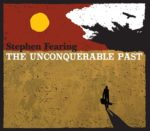 Stephen Fearing’s thirteenth solo album’s very personal and, at the same time it’s also political, but this isn’t just one for the social theorists because those elements are inextricably linked with the musical settings for the songs. Three of the songs on the album are named for people and there’s a strong vein of nostalgia running through the lyrical and musical stylings of “The Unconquerable Past”, although this isn’t by any means wallowing in the past; it’s much more of a realisation that there’s always a danger of dismissing older musical styles as no longer relevant in the headlong rush to be on-trend. It’s not a new thing, those wonderful old cynics Becker and Fagen nailed it in their own beautifully sleazy way in “Hey Nineteen” in 1980: ‘Hey, nineteen, that’s ‘Retha Franklin, she don’t remember the Queen of Soul’.
Stephen Fearing’s thirteenth solo album’s very personal and, at the same time it’s also political, but this isn’t just one for the social theorists because those elements are inextricably linked with the musical settings for the songs. Three of the songs on the album are named for people and there’s a strong vein of nostalgia running through the lyrical and musical stylings of “The Unconquerable Past”, although this isn’t by any means wallowing in the past; it’s much more of a realisation that there’s always a danger of dismissing older musical styles as no longer relevant in the headlong rush to be on-trend. It’s not a new thing, those wonderful old cynics Becker and Fagen nailed it in their own beautifully sleazy way in “Hey Nineteen” in 1980: ‘Hey, nineteen, that’s ‘Retha Franklin, she don’t remember the Queen of Soul’.
To come back to Stephen Fearing, this album is a bit of a departure from his solo material in that, at times, there’s a full rock band behind some uptempo tunes, one of which, “Christine”, goes way back to classic rockabilly styling and it’s a lot of fun. The other notably uptempo song, “Stay with Me” has its roots firmly in drivetime rock that Bob Seger seemed to knock out for fun in the late seventies.
If there’s one theme above all others pulling the album together it’s empathy, particularly where people with differences are dealing with harsh and unforgiving society we live in today. “Sunny” is a great example as the story is gradually revealed of a transgender individual leaving home to eventually find a relationship that works. The writer isn’t judging, and preaches the same tolerance in “Someone Else’s Shoes”; we should always try to understand the pressures someone else is facing rather than rushing to condemn.
Personal highlights are the poignant “Emigrant Song”, co-written with Andy White, dealing with the conflicting tensions of moving and looking back at happy memories, and the title song, with the message that we are products of our past but we don’t have to be defined by it. The album closes out with “No Country”, a solo acoustic ballad that positions the troubadour as a citizen of nowhere at all.
“The Unconquerable Past” is a collection of ten high-calibre songs performed with quality and taste that will make you tap your feet and make you stop and think. Not a bad combination.
“The Unconquerable Past” is out in the UK now in various physical and digital formats of Fish Records (FRCD03).
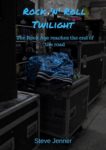 We don’t get too many chances to do book reviews, but I’m absolutely insisting on doing this one. “Rock ‘n’ Roll Twilight” is the work of our very own contributor, and friend for longer than either of us can remember, Steve Jenner. The central premise of the book is very simple; the golden age of rock ’n’ roll, for a variety of reasons, is over and we’re now witnessing what my friends who still live Up North would call its last knockings. I’m not going into that in detail, because I’m hoping you’re going to read it for yourself and find out.
We don’t get too many chances to do book reviews, but I’m absolutely insisting on doing this one. “Rock ‘n’ Roll Twilight” is the work of our very own contributor, and friend for longer than either of us can remember, Steve Jenner. The central premise of the book is very simple; the golden age of rock ’n’ roll, for a variety of reasons, is over and we’re now witnessing what my friends who still live Up North would call its last knockings. I’m not going into that in detail, because I’m hoping you’re going to read it for yourself and find out.
Besides the basic premise, what Steve has done is collected a series of reviews written during his lengthy odyssey to try to catch as many of the bands that we have loved over the years while we still have the opportunity. Sometimes the attempt to catch the bands has only been partially successful; in the period between buying tickets for Steely Dan and seeing the show, Walter Becker (one half of the partnership) died and the show had some of the feel of an upbeat memorial. The artists reviewed cover a diversity of musical styles and range from global megastars to not-even-a-hit-in-the-UK. It’s a perfect cross-section of the music that is only rock ‘n’ roll (but we like it). Some of the reviews have appeared here in the past; some haven’t and I’m hoping we’ll see more in the future.
Don’t get the idea that this is a favour for a mate. We only feature bands, gigs, albums, singles and even books on MusicRiot that we love and we want to share with the world. The other thing is that Steve can write; no argument on that at all. Here’s an example from the book and my favourite intro to a review:
‘My mate can drink 3 pints of lager through a straw in less time than it takes to boil a kettle.
According to some, this makes him a ‘legend’.
Brian Wilson is regarded by many as a ‘genius’.
I would argue these labels have caused problems for both men and have probably influenced their behaviour and probably not in a good way.’
Steve has also given credit to some unsung heroes; the actual venues hosting these events. The final section of the book is a series of short pieces about the places these bands were seen in, ranging from the Foxlowe Centre in Leek to the O2 in Greenwich and all shapes and sizes in between. Part fact/part personal opinion, it gives real feel for ambience of these buildings.
Writing’s a skill; you can learn, you can make yourself better. The unique qualities that make this a standout piece of work are Steve’s knowledge of his subject (trust me, most of this stuff is in his head) and his sheer enthusiasm for all aspects of music. Passion, knowledge and skilful writing combine to create a little gem that you won’t want to put down.
And I was almost too modest to mention that I took the cover shot; almost.
Ok, call me obsessive if you like but as well as listening to a lot of albums and going to as many gigs as I can, I also read the odd book or two about music and popular culture and many of those are worth sharing with anyone who checks out MusicRiot regularly. This list was difficult to pin down to five from the start, but it became even more difficult on Christmas Day when I was given a copy of the Donald Fagen memoir/tour diary/article compilation, “Eminent Hipsters”. So I guess that’s a pretty good place to start.
“Eminent Hipsters” – Donald Fagen
 Where do I start with Donald Fagen? With Walter Becker, he was half of one of my favourite 70s bands, Steely Dan and then went on to release the classic solo album, “The Nightfly” in 1982, followed (not too closely) by “The Kamakiriad” in 1993. You’ve probably guessed by now, I’m a bit of a fan. “Eminent Hipsters” is partly an explanation, through a series of articles, of the factors which influenced the Steely Dan sound (cool jazz, cop dramas and wise-ass comedians) and the Donald Fagen solo sound (science fiction and mid-century paranoia). If you love the music, you’ll be fascinated by these observations about its roots. The second part of this slim volume is devoted to Fagen’s diary from the 2012 “Dukes of September Rhythm Revue” tour which is, by turn, snarky, moving, insightful and downright hilarious.
Where do I start with Donald Fagen? With Walter Becker, he was half of one of my favourite 70s bands, Steely Dan and then went on to release the classic solo album, “The Nightfly” in 1982, followed (not too closely) by “The Kamakiriad” in 1993. You’ve probably guessed by now, I’m a bit of a fan. “Eminent Hipsters” is partly an explanation, through a series of articles, of the factors which influenced the Steely Dan sound (cool jazz, cop dramas and wise-ass comedians) and the Donald Fagen solo sound (science fiction and mid-century paranoia). If you love the music, you’ll be fascinated by these observations about its roots. The second part of this slim volume is devoted to Fagen’s diary from the 2012 “Dukes of September Rhythm Revue” tour which is, by turn, snarky, moving, insightful and downright hilarious.
Donald Fagen writes in an instantly-identifiable style betraying a debt to Raymond Chandler and Dashiell Hammett, which sneaks in when describing Audrey Hepburn in “Breakfast at Tiffany’s” as getting :”out of that cab on Fifth Avenue in a black dress and pearls in the early morning, I wanted to sip her through a straw”. It’s beautifully written and you can get through it in a few hours; it takes 170 pages to deliver a message that most rock biographies take at least five times as long to get over.
“Bedsit Disco Queen: How I Grew Up and Tried to be a Pop Star” – Tracey Thorn
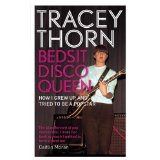 If Donald Fagen’s prose style is easily identifiable, then Tracey Thorn’s is even more so. I’m always impressed when musicians get this right (Peter Hook and Luke Haines also do it particularly well) and, from the first paragraph, this is pitch-perfect ‘Popstar Trace’. The book takes us from the Marine Girls beginnings through the EBTG false starts and eventual success to the beautiful Massive Attack vocals (I’m biased, but you should read about the origins of the modern classic, “Protection” here) and the worldwide Todd Terry-remixed success of “Missing”.
If Donald Fagen’s prose style is easily identifiable, then Tracey Thorn’s is even more so. I’m always impressed when musicians get this right (Peter Hook and Luke Haines also do it particularly well) and, from the first paragraph, this is pitch-perfect ‘Popstar Trace’. The book takes us from the Marine Girls beginnings through the EBTG false starts and eventual success to the beautiful Massive Attack vocals (I’m biased, but you should read about the origins of the modern classic, “Protection” here) and the worldwide Todd Terry-remixed success of “Missing”.
Tracey’s style is perfectly self-deprecatory; you never feel a hint of false modesty and the mentions of famous musicians are always very matter-of-fact, including the story about waiting to pick the kids up from school and being shouted at by George Michael from a Range Rover. This is a wonderful memoir from a genuine pop star.
“Yeah, Yeah, Yeah: The Story of Modern Pop” – Bob Stanley
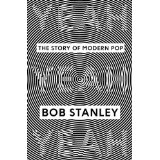 It’s obvious from the outset that this is actually a companion piece to the classic 2012 St Etienne album, “Words and Music”. The album was a voyage through the history of British pop music and the book is an extended verbal remix of the ground covered by the album. What’s equally obvious is that Bob Stanley is both an enthusiast and an insider, which gives him a unique perspective on his subject. He aims to show the links between different styles using not just the music, but also sociological and technological developments. If you’re interested in the history of pop music and you’ve done a bit of research, you might disagree with some of his pronouncements, but it’s a big book and you’ll probably agree with ninety per cent of them.
It’s obvious from the outset that this is actually a companion piece to the classic 2012 St Etienne album, “Words and Music”. The album was a voyage through the history of British pop music and the book is an extended verbal remix of the ground covered by the album. What’s equally obvious is that Bob Stanley is both an enthusiast and an insider, which gives him a unique perspective on his subject. He aims to show the links between different styles using not just the music, but also sociological and technological developments. If you’re interested in the history of pop music and you’ve done a bit of research, you might disagree with some of his pronouncements, but it’s a big book and you’ll probably agree with ninety per cent of them.
The book takes the first NME chart in 1952 as its starting point (which is logical and not controversial) and the end of vinyl as a chart force in 1993 as its end point, when the first Number One singles not to have been released as a 7” single or (a few months later) on vinyl at all topped the charts (if you want to know what they are, you can buy the book ). It’s a slightly more controversial choice but still with a logical basis for someone who grew up in the age of vinyl. The book has an authority derived from Bob Stanley’s experience as a writer and member of a very successful pop group but never slips into the socio-cultural academic approach of, for example, Simon Reynolds. The theme that underpins everything else in this book is that Bob Stanley is still a fan who wants you to come round and listen to his records, and that makes this an unmissable book.
“Here Comes Everybody: The Story of the Pogues” – James Fearnley
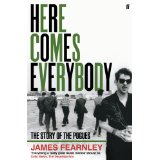 I’ve always been a fan of the “inside story” biography, particularly those that aren’t ghost-written attempts at cultural revisionism. This memoir by James Fearnley is, at times, brutally and crushingly honest about members of The Pogues and he doesn’t spare himself either. The book begins by setting the scene with Shane MacGowan’s departure from the band in 1991 before moving back to Fearnley’s initial meeting with MacGowan at an audition for The Nips in 1980.
I’ve always been a fan of the “inside story” biography, particularly those that aren’t ghost-written attempts at cultural revisionism. This memoir by James Fearnley is, at times, brutally and crushingly honest about members of The Pogues and he doesn’t spare himself either. The book begins by setting the scene with Shane MacGowan’s departure from the band in 1991 before moving back to Fearnley’s initial meeting with MacGowan at an audition for The Nips in 1980.
The book is a (mainly) unsentimental account of the rise and fall of The Pogues from the viewpoint of someone close enough to see everything but with enough distance to retain some objectivity. From the chaotic managerless beginnings through the unpopular but successful stewardship of Frank Murray, the story is underpinned at all times by MacGowan’s unpredictability and seemingly random self-destructive urges. James Fearnley tries very hard to balance the singer’s inexcusable behaviour against the genius of the songs, but it’s up to you if you buy that line; I certainly don’t. My only criticism is that James Fearnley spends a little too much time trying to emphasise the fact that he’s a writer and occasionally introduces unnecessarily florid prose to prove it; putting that aside, it’s still a winner.
“Sounds like London: 100 Years of Black Music in the Capital” – Lloyd Bradley
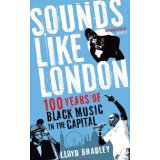 Bear with me for a minute here; this will all make sense presently. Earlier this year I read “How Soon is Now?: The Madmen and the Mavericks who made Independent Music 1975-2005” by Richard King. It’s a very good book and a must for geeks like us, but it attracted a lot of criticism because it didn’t touch on the black music scene. Richard King was even accused, pathetically, of racism in some quarters; you might even have read about it. Personally, I prefer to read authors who write about subjects they understand and that really inspire them; if Richard King didn’t have the expertise, contacts or inspiration to write about the black music scene, then Lloyd Bradley certainly did.
Bear with me for a minute here; this will all make sense presently. Earlier this year I read “How Soon is Now?: The Madmen and the Mavericks who made Independent Music 1975-2005” by Richard King. It’s a very good book and a must for geeks like us, but it attracted a lot of criticism because it didn’t touch on the black music scene. Richard King was even accused, pathetically, of racism in some quarters; you might even have read about it. Personally, I prefer to read authors who write about subjects they understand and that really inspire them; if Richard King didn’t have the expertise, contacts or inspiration to write about the black music scene, then Lloyd Bradley certainly did.
The title is a little misleading; there’s very little about pre-1950s black music, and it also deals with regional English offshoots from the London scene but those aren’t criticisms, just observations. The reason for the comparison with Richard King’s book is that one of Lloyd Bradley’s recurring themes is that black British music has always developed and prospered healthily out of the mainstream when produced and distributed independently.
Once the book reaches the point where Lloyd Bradley can introduce interviews with the players who made black British music happen (the steel pan players, the jazzers, the sound system pioneers, the Britfunk players and the mainstream crossovers Eddy Grant, Janet Kay, Jazzie B and the rest), the narrative really takes off with stories of the sound systems and records being sold out of the back of a car and distributed around the country in the same way. Lloyd Bradley takes us through calypso, ska, reggae, lovers rock, dub, britfunk, 98 bpm, trip hop, jungle, d’n’b, UK garage, dubstep and grime along with a host of short-lived one-way streets with an unassuming and easy authority that is very seductive. If you want an introduction to black British music, this is the book for you.
OK, spoilers alert; I’ve relented. I’ll tell you that the chart-toppers Bob Stanley refers to in 1993 and 1995 respectively are Culture Beat’s “Mr Vain” and Celine Dion’s “Think Twice”, but you should still read the book. Actually you should read all of these books.


